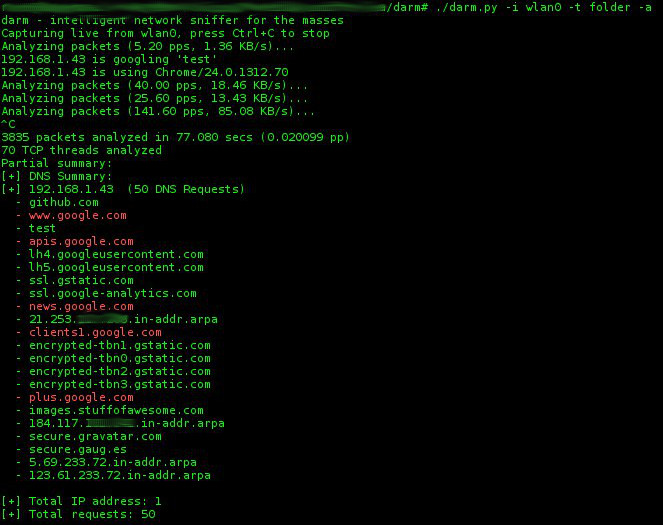

To read an IP packet you need to analyze the received packet in binary according to the IP protocol. Raw socket is a socket the sends and receives data in binary.īinary in python is represented in a string which looks like this \x00\xff… every \x. You can sniff all of the IP packets using a raw socket. user November 30, -0001 at 12:00 am The hard way.I sent a new defect ticket to the Scapy developers:, hope they can do something with it.Īnyways, just thought I’d let y’all know. I installed the original version of PyPcap (from Google’s site), and Scapy started working fine (I didn’t try many things, but at least it didn’t crash as soon as I started sniffing). It was this modified PyPcap that was causing the problem, apparently, since the example in the answer also caused a hang.
#Python http sniffer install#
(If anyone is interested, I’m running Windows Vista, which might affect things).Īfter reading the answer telling me to install PyPcap, I messed around with it a bit and found out that Scapy, which I had tried using, was telling me to install PyPcap as well, except that it’s a modified version for it’s use. I would assume that it’s just a problem with how I installed it, except that many other people have told me that it doesn’t work particularly well on Windows. I’ve heard from several places that the best module for this is a module called Scapy, unfortunately, it makes python.exe crash on my system. Prn=lambda pkt: pprint.pprint(pkt.getlayer(scapy_).What is the best way to sniff network packets using Python?
#Python http sniffer how to#
# demoing how to only match HTTP requests and to access the HTTP headers as pre-created dict's instead of # There is no reason not to use a function you write for this but I just wanted to keep the example simply while # Sniff for the data and print it using lambda instead of writing a function to pretty print. Parser.add_argument("-count", "-c", help="Number of packets to capture. Parser.add_argument("-filter", "-f", help='BPF formatted packet filter.', default="tcp and port 80")

Parser.add_argument("-interface", "-i", help="Which interface to sniff on.", default="eth0")

# Parser command line arguments and make them available.įormatter_class=argparse.ArgumentDefaultsHelpFormatter,ĭescription="Print HTTP Request headers (must be run as root or with capabilities to sniff).", ("You can install it by running: sudo pip install -U 'scapy>=2.3,=1.8'") ("ERROR: You must have scapy installed.\n") # Try to import sniff from scapy.all and show error w/ install instructions if it cannot be imported. Logging.getLogger("ntime").setLevel(logging.ERROR) This needs to be done before the import from scapy. # Suppress scapy warning if no default route for IPv6. Aside from the formatting, this seems like the most efficient means posted on this question so far and you can delegate to a function to add formatting and further deconstruct the dict. This won't have the asterisk packet breaks but instead just prints the headers as pretty printed dictionary so this may work for you or may not but you can also customize it to suit your needs. I had commented on one way to improve it but I decided to whip together a more complete solution. You also need to split the string returned from it and join it back together with newline characters, otherwise it spits it out all on one line: #!/usr/bin/python You need to use the sprintf function of the packet instead of printing the packet itself.

#Python http sniffer code#
I am trying to code a simple sniffer in Scapy, which only prints HTTP packets with GET method only.


 0 kommentar(er)
0 kommentar(er)
